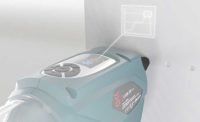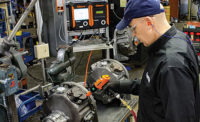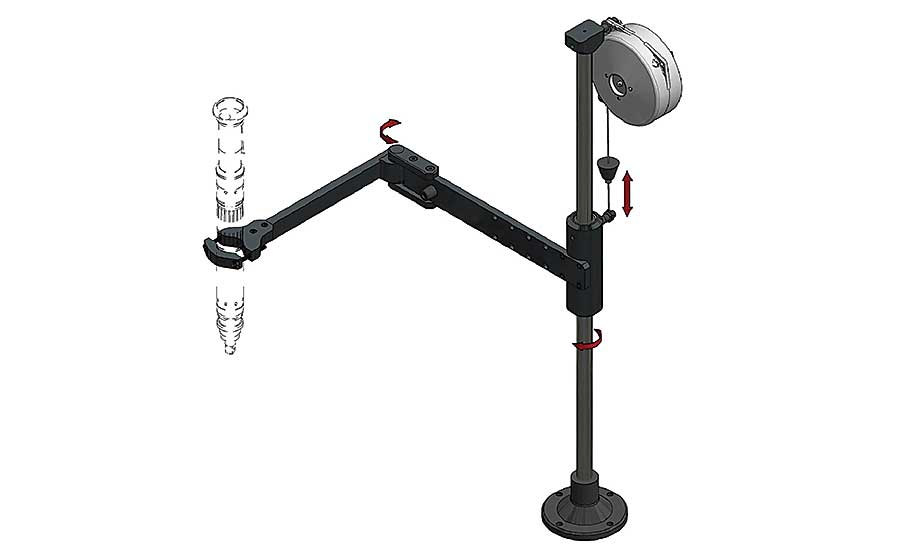Tool Balancers and Support Arms
Traditional tool balancers and evolving support arms boost worker efficiency and safety








There are good and bad aspects to repetition. On one hand, it’s a proven way to learn to expertly perform a task. On the other, it can lead to physical problems like carpal tunnel syndrome, and bad arthritis in the hands, arms, legs and back.
Assembly line workers know all about the negative consequences of excessive repetitive motion. Fortunately, equipment suppliers do as well, and offer a wide range of tool balancers and support arms that improve worker ergonomics and counter the downside of performing repetitive tasks.
“In the old days, big guys were the only ones who did the repetitive jobs,” says Ken Maio, business development manager at AIMCO Global. “Today, big and small people from a broad range of cultures do this work. Tool balancers and support arms not only help them do it well, but also comfortably and safely.”
AIMCO has sold balancers and arms since the 1970s as accessories for their power tools and measurement equipment. The supplier’s latest support arms include one made of carbon fiber for easier movement, and one with encoders in the joints that operates with a controller by itself or with a PC and specialty software.
FlexArm also offers a carbon fiber arm, as well as an articulated model called the AR40. Last year, an off-highway equipment manufacturer installed 24 AR40 arms on two assembly lines to help workers perform nutrunning more ergonomically. Jeff Dauterman, ergonomic sales manager at FlexArm, says that its arms have proven much more productive than the pneumatic counterbalance arms that the manufacturer had been using. Those arms also had to be initially modified and regularly maintained.
According to equipment suppliers, support arms are an evolving accessory, while balancers remain a simpler, but still reliable, commodity. Each product has a specific purpose, and offers essential benefits, in a workstation or on the assembly line.
Weight Problem Solved
Tool balancers help to reduce fatigue and increase safety by making it easier for workers to lift and move the tool in their work space. Balancers come in several types, with spring and zero gravity being the most popular.
Spring balancers are recommended for lightweight assembly tools like pneumatic and electric screwdrivers. Zero-gravity balancers are better for large impact and pulse tools.
Spring balancers, also called retractors, feature a spring-loaded wire reel that exerts an upward force on a tool to lift it up and out of the way when not in use. The reel is clipped to the tool, which is then powered by a separate pneumatic umbilical and lifted either partially out of the way or all the way up to the reel.
Air spring balancers feature a pneumatic hose reel instead of a wire one. This hose is directly connected to the tool and supports it when wound and unwound in the retractor.
Wire reel retractors allow for a quick tool change-out, so long as the umbilical doesn’t get in the way. The umbilical may also limit the travel distance of the wire reel. A hose reel, in contrast, allows the operator to take full advantage of the system’s rated travel distance.
The drawback of the hose reel is it typically has a bulkier feel that can bother operators who are continually pulling it down and letting it go. Hose reels also offer less flexibility because they can only be used with pneumatic tools and removing them for maintenance requires tool detachment and reattachment.
Both types of retractors install easily with hooks, shackles and clips. Manufacturers can attach a retractor to an existing overhead structure or a purpose-built device.
The TW series of spring balancers from AIMCO consists of 12 models. The smallest unit, TW-00, handles tools from 1.1 to 3.3 pounds, while the largest unit has a capacity of 132 to 154 pounds.
Zero-gravity balancers feature a tension spring that counterbalances the weight of the tool so it can be held at the exact point where the operator releases it. By leaving the tool hanging in midair, the balancer eliminates the need for the operator to reach up and retrieve it.
If the tool is used in just one of many operations at a workstation, the benefit is limited. But, if the operator needs to install multiple fasteners with a single tool, having it immediately and comfortably at hand is a big ergonomic advantage. Mountz Inc.’s MZ series of zero-gravity balancers includes 15 models with strokes from 19 to 82 inches, and capacities from 1.1 to 264 pounds.
Zero-gravity air balancers incorporate a pneumatic hose for air-powered tools. Similar to an air spring balancer, the hose supports the tool when wound and unwound in the balancer reel.
Vertical balancers fully support a tool’s weight and are designed for bigger jobs. These devices move up and down with the aid of a pneumatic
cylinder, and are generally moved to and from a work piece using an overhead rail system.
Regardless of the balancer type, the operator needs to make sure that its weight capacity matches that of applicable tools. Ignoring this guideline can lead to problems.
“Operators often misuse balancers by using them with tools that are matched incorrectly to the capacity of the balancer in use,” notes Maio. “Tools that are too heavy often won’t retract, whereas tools that are too light can over-rotate and be very difficult to pull down.”
Maio says the best balancer for an application is the one that requires the least amount of worker effort. A setup that requires an operator to lift and put down a tool every minute or so, for example, is one that involves extra movement and lowers productivity.
Reaction Reduction
Lessening tool weight is one way to minimize operator fatigue. Another way is to greatly limit the amount of tool torque reaction that the assembler repeatedly absorbs. Torque-reaction arms provide both benefits.
Depending on the model, an arm is rated to absorb 10 to 7,500 newton-meters of torque each cycle from air- and electric-powered screwdrivers, nutrunners, tappers and hand drills. Each arm is designed to move in a linear, telescoping or articulating manner.
“In the last 15 years, torque arms have gotten smaller, lighter and more versatile and advanced,” says Dave Cash, technical application specialist at Mountz Inc. “You increasingly see arms used in both heavy and light duty applications because they increase worker accuracy. Equally important, the arms provide 100 percent of the torque to the fastener.”
Usually, the arm holds the tool so that it remains in a vertical orientation. Adapters are available, though, that allow the operator to set the tool horizontally or at an angle.
Regardless of orientation, the arm always keeps the tool in alignment with the fastener and work piece. This not only eliminates cross-threading, broken bits, screw head burrs and out-of-square fasteners. It also reduces cycle times.
A linear arm is a single-piece unit that smoothly revolves around, and travels up and down on, a fixed shaft. Telescoping arms move in and out a set distance, and are effective for applications requiring a tool to be used in a tight vertical space. Many linear and telescoping arms feature an end clamp that rotates a straight or pistol-grip tool 90 degrees.
Last year, FlexArm introduced its LR40 linear arm for use in tight-space applications, such as tightening two bolts that are close to each other. Dauterman says the arm is rated to 40 ft-lbs and slides in and out from 8 to 31.25 inches. It has a counterbalance up to 10 pounds and can be mounted in any of four orientations, including from the ceiling.
GCI has been making custom carbon fiber (CF) torque and manipulator arms since 2009. Company president Jeff Golberg claims that GCI is the only supplier in the industry to offer long-reach CF arms. Currently, GCI makes CF arms up to 20 feet long with torque ratings of 30 to 7,500 newton-meters.
“Because our customers often need to perform large vehicle assembly, they regularly deal with floor-space-restriction challenges,” explains Golberg. “With our long arms, however, the assemblers are able to mount the arm in one spot and still fully access both sides of a vehicle.”
GCI makes its arms out of CF for several reasons, according to Golberg. The material is much lighter than steel, as well as being more rigid and better able to maintain its ergonomic benefit to users at extended lengths.
“A steel arm is basically twice the weight of a comparable carbon fiber one,” says Todd Gieseke, director of engineering at GCI. “This means that a 20-foot-long-reach fiber arm weighs about as much as a 10-foot-long-reach steel one. And that extra 10 feet is a big benefit to operators.”
“Carbon fiber’s weight and strength benefits are important to manufacturers, but don’t really kick in until the application requires large, heavy and high-torque tools,” adds Golberg.
Industries served by GCI include heavy equipment, automotive, marine, aerospace, recreational vehicles and material handling. Golberg points out that customers tend to be high-volume manufacturers that operate assembly lines of 20 to 40 workstations, with each station featuring one or two arms.
Articulated arms have one or more joints that allow the operator to use the tool in the entire area within the arm radius. Models use an adjustable pneumatic, a sealed high-pressure spring or a hybrid system to support the tool’s weight. All three systems perform well, but the spring type costs less and is harder to fine-tune.
Several models feature two pivot points that enable the tool to move freely along the X and Y axes. Some suppliers even integrate encoders in the joints so the arm can be used for guided assembly. These encoders are tracked by a nearby control box to help the operator place the DC tool in the correct location before installing a fastener and install fasteners on a product in the right sequence.
The DPC-Touch Posi-Control System from Mountz helps operators who use articulated arms make sure that every screw is properly tightened in the correct sequence. Quick and easy to setup, the system is compatible with DC-controlled tools, torque electric screwdrivers (with transformers or controllers) and air tools (ported). It has self-teaching and automation program modes, and lets operators establish specific positioning-tolerance parameters, minimum and maximum time for Poka Yoke control, and save 99 memory points.
The TLS1/CAR articulated smart arm by KolverUSA has a 25 newton-meter torque rating and is made of carbon fiber. According to Dan Smith, general manager at Kolver, a pivot-point encoder and a linear metering resistor reliably measure all of the arm’s length and angle movements.
“This system takes full control of walking the operator through ‘acceptable’ patterns based on each application’s needs,” notes Smith. “However, if the operator does not follow a specific preprogrammed pattern, the driver is shut off and not allowed to run until put into the proper position.”
AIMCO’s AcraDyne Gen IV Ace controller provides smart-arm operators with process visualization in a single system. Real-time data is captured by encoders located at each arm joint and then represented in an image on the
controller screen. Once fastener locations and sequences are programmed into the controller, the system performs specific actions on specific fasteners.
Maio notes that the controller requires no external PC and uses its own integrated software. It works with all of the company’s continuous- and discontinuous-drive transducerized tools, which have a torque capacity from 1 to 12,000 newton-meters.
“Manufacturers often come to us to purchase an arm after a worker injury has occurred, and that’s understandable,” says Dauterman. “What’s problematic, though, is when a customer uses the arm improperly, especially in nonautomated, lower-volume applications.
“Usually, the customer removes the arm’s counterbalancing weight and equips the arm with an end-effector to use it as a pick-and-place part manipulator. What they fail to understand is the modified arm can spring up and down on its own and hurt the operator. A torque-reaction arm is not a robotic arm. The two are totally different.”
Looking for a reprint of this article?
From high-res PDFs to custom plaques, order your copy today!









